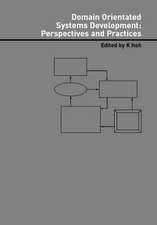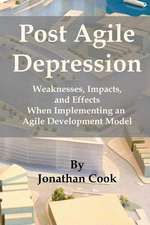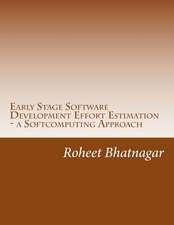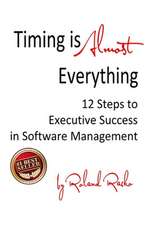Core Software Security: Security at the Source
Autor James Ransome, Anmol Misraen Limba Engleză Paperback – 30 iun 2021
—Dr. Dena Haritos Tsamitis. Carnegie Mellon University
"... a must read for security specialists, software developers and software engineers. ... should be part of every security professional’s library."
—Dr. Larry Ponemon, Ponemon Institute
"... the definitive how-to guide for software security professionals. Dr. Ransome, Anmol Misra, and Brook Schoenfield deftly outline the procedures and policies needed to integrate real security into the software development process. ...A must-have for anyone on the front lines of the Cyber War ..."
—Cedric Leighton, Colonel, USAF (Ret.), Cedric Leighton Associates
"Dr. Ransome, Anmol Misra, and Brook Schoenfield give you a magic formula in this book - the methodology and process to build security into the entire software development life cycle so that the software is secured at the source! "
—Eric S. Yuan, Zoom Video Communications
There is much publicity regarding network security, but the real cyber Achilles’ heel is insecure software. Millions of software vulnerabilities create a cyber house of cards, in which we conduct our digital lives. In response, security people build ever more elaborate cyber fortresses to protect this vulnerable software. Despite their efforts, cyber fortifications consistently fail to protect our digital treasures. Why? The security industry has failed to engage fully with the creative, innovative people who write software.
Core Software Security expounds developer-centric software security, a holistic process to engage creativity for security. As long as software is developed by humans, it requires the human element to fix it. Developer-centric security is not only feasible but also cost effective and operationally relevant. The methodology builds security into software development, which lies at the heart of our cyber infrastructure. Whatever development method is employed, software must be secured at the source.
Book Highlights:
- Supplies a practitioner's view of the SDL
- Considers Agile as a security enabler
- Covers the privacy elements in an SDL
- Outlines a holistic business-savvy SDL framework that includes people, process, and technology
- Highlights the key success factors, deliverables, and metrics for each phase of the SDL
- Examines cost efficiencies, optimized performance, and organizational structure of a developer-centric software security program and PSIRT
- Includes a chapter by noted security architect Brook Schoenfield who shares his insights and experiences in applying the book’s SDL framework
| Toate formatele și edițiile | Preț | Express |
|---|---|---|
| Paperback (1) | 498.52 lei 6-8 săpt. | |
| CRC Press – 30 iun 2021 | 498.52 lei 6-8 săpt. | |
| Hardback (1) | 942.99 lei 6-8 săpt. | |
| Routledge – 9 dec 2013 | 942.99 lei 6-8 săpt. |
Preț: 498.52 lei
Preț vechi: 623.15 lei
-20% Nou
Puncte Express: 748
Preț estimativ în valută:
95.39€ • 99.85$ • 79.40£
95.39€ • 99.85$ • 79.40£
Carte tipărită la comandă
Livrare economică 31 martie-14 aprilie
Preluare comenzi: 021 569.72.76
Specificații
ISBN-13: 9781032027418
ISBN-10: 103202741X
Pagini: 414
Ilustrații: 16 Tables, black and white; 53 Illustrations, black and white
Dimensiuni: 156 x 234 x 22 mm
Greutate: 4.21 kg
Ediția:1
Editura: CRC Press
Colecția Auerbach Publications
ISBN-10: 103202741X
Pagini: 414
Ilustrații: 16 Tables, black and white; 53 Illustrations, black and white
Dimensiuni: 156 x 234 x 22 mm
Greutate: 4.21 kg
Ediția:1
Editura: CRC Press
Colecția Auerbach Publications
Public țintă
Professional Practice & DevelopmentCuprins
Introduction. The Secure Development Lifecycle. Security Assessment (A1): SDL Activities and Best Practices. Architecture (A2): SDL Activities and Best Practices. Design and Development (A3): SDL Activities and Best Practices. Design and Development (A4): SDL Activities and Best Practices. Ship (A5): SDL Activities and Best Practices. Post-Release Support (PRSA1–5). Applying the SDL Framework to the Real World. Pulling It All Together: Using the SDL to Prevent Real-World Threats.
Notă biografică
Dr. James Ransome is the Senior Director of Product Security and responsible for all aspects of McAfee’s Product Security Program, a corporate-wide initiative that supports McAfee’s business units in delivering best-in-class, secure software products to customers. In this role, James sets program strategy, manages security engagements with McAfee business units, maintains key relationships with McAfee product engineers, and works with other leaders to help define and build product security capabilities. His career has been marked by leadership positions in private and public industries, including three chief information security officer (CISO) and four chief security officer (CSO) roles. Prior to entering the corporate world, James had 23 years of government service in various roles supporting the U.S. intelligence community, federal law enforcement, and the Department of Defense.
James holds a Ph.D. in Information Systems. He developed/tested a security model, architecture, and provided leading practices for converged wired/wireless network security for his doctoral dissertation as part of a NSA/DHS Center of Academic Excellence in Information Assurance Education program. He is the author of several books on information security, and Core Software Security: Security at the Source is his 10th. James is a member of Upsilon Pi Epsilon, the International Honor Society for the Computing and Information Disciplines, and he is a Certified Information Security Manager (CISM), a Certified Information Systems Security Professional (CISSP), and a Ponemon Institute Distinguished Fellow.
Anmol Misra is an author and a security professional with a wide range of experience in the field of information security. His expertise includes mobile and application security, vulnerability management, application and infrastructure security assessments, and security code reviews. He is a Program Manager in Cisco’s Information Security group. In this role, he is responsible for developing and implementing security strategy and programs to drive security best practices into all aspects of Cisco’s hosted products. Prior to joining Cisco, Anmol was a Senior Consultant with Ernst & Young LLP. In this role, he advised Fortune 500 clients on defining and improving information security programs and practices. He helped corporations to reduce IT security risk and achieve regulatory compliance by improving their security posture.
Anmol is co-author of Android Security: Attacks and Defenses, and is a contributing author of Defending the Cloud: Waging War in Cyberspace. He holds a master’s degree in Information Networking from Carnegie Mellon University and a Bachelor of Engineering degree in Computer Engineering. He is based out of San Francisco, California.
James holds a Ph.D. in Information Systems. He developed/tested a security model, architecture, and provided leading practices for converged wired/wireless network security for his doctoral dissertation as part of a NSA/DHS Center of Academic Excellence in Information Assurance Education program. He is the author of several books on information security, and Core Software Security: Security at the Source is his 10th. James is a member of Upsilon Pi Epsilon, the International Honor Society for the Computing and Information Disciplines, and he is a Certified Information Security Manager (CISM), a Certified Information Systems Security Professional (CISSP), and a Ponemon Institute Distinguished Fellow.
Anmol Misra is an author and a security professional with a wide range of experience in the field of information security. His expertise includes mobile and application security, vulnerability management, application and infrastructure security assessments, and security code reviews. He is a Program Manager in Cisco’s Information Security group. In this role, he is responsible for developing and implementing security strategy and programs to drive security best practices into all aspects of Cisco’s hosted products. Prior to joining Cisco, Anmol was a Senior Consultant with Ernst & Young LLP. In this role, he advised Fortune 500 clients on defining and improving information security programs and practices. He helped corporations to reduce IT security risk and achieve regulatory compliance by improving their security posture.
Anmol is co-author of Android Security: Attacks and Defenses, and is a contributing author of Defending the Cloud: Waging War in Cyberspace. He holds a master’s degree in Information Networking from Carnegie Mellon University and a Bachelor of Engineering degree in Computer Engineering. He is based out of San Francisco, California.
Recenzii
First and foremost, Ransome and Misra have made an engaging book that will empower readers in both large and small software development and engineering organizations to build security into their products. This book clarifies to executives the decisions to be made on software security and then provides guidance to managers and developers on process and procedure. Readers are armed with firm solutions for the fight against cyber threats.
—Dr. Dena Haritos Tsamitis, Director, Information Networking Institute and Director of Education, CyLab Carnegie Mellon University
Finally, the definitive how-to guide for software security professionals. Dr. Ransome, Anmol Misra, and Brook Schoenfield deftly outline the procedures and policies needed to integrate real security into the software development process and why security needs to be software and developer-centric if it is to be relevant. A must-have for anyone on the front lines of the Cyber War - especially software developers and those who work with them.
—Cedric Leighton, Colonel, USAF (Ret); Founder & President, Cedric Leighton Associates
In the wake of cloud computing and mobile apps, the issue of software security has never been more important than today. This book is a must read for security specialists, software developers and software engineers. The authors do a brilliant job providing common sense approaches to achieving a strong software security posture.
—Dr. Larry Ponemon, Chairman & Founder, Ponemon Institute
The root of software security lies within the source code developed by software developers. Therefore, security should be developer-centric, focused on the secure development of the source code. Dr. Ransome, Anmol Misra, and Brook Schoenfield give you a magic formula in this book - the methodology and process to build security into the entire software development life cycle so that the software is secured at the source!
—Eric S. Yuan, Founder and CEO, Zoom Video Communications, Inc
Misra and his co-author James Ransome, senior director of product security at McAfee, an Intel Company, reflected on years of lessons learned and experiences with Fortune 500 clients and devised a methodology that builds security into software development. The newly published book Core Software Security, Security at the Source takes an innovative approach that engages the creativity of the developer. ... The book covers embedding security as a part of existing software development methods, and how security can be a business enabler and a competitive differentiator. Throughout the book, the authors describe a modern, holistic framework for software security that includes people, process and technology. The book includes metrics, cost effectiveness, case studies, threat modeling and considerations for mobile software and privacy.
—Sherry Stokes, writing in Carnegie Mellon News, May 2014
—Dr. Dena Haritos Tsamitis, Director, Information Networking Institute and Director of Education, CyLab Carnegie Mellon University
Finally, the definitive how-to guide for software security professionals. Dr. Ransome, Anmol Misra, and Brook Schoenfield deftly outline the procedures and policies needed to integrate real security into the software development process and why security needs to be software and developer-centric if it is to be relevant. A must-have for anyone on the front lines of the Cyber War - especially software developers and those who work with them.
—Cedric Leighton, Colonel, USAF (Ret); Founder & President, Cedric Leighton Associates
In the wake of cloud computing and mobile apps, the issue of software security has never been more important than today. This book is a must read for security specialists, software developers and software engineers. The authors do a brilliant job providing common sense approaches to achieving a strong software security posture.
—Dr. Larry Ponemon, Chairman & Founder, Ponemon Institute
The root of software security lies within the source code developed by software developers. Therefore, security should be developer-centric, focused on the secure development of the source code. Dr. Ransome, Anmol Misra, and Brook Schoenfield give you a magic formula in this book - the methodology and process to build security into the entire software development life cycle so that the software is secured at the source!
—Eric S. Yuan, Founder and CEO, Zoom Video Communications, Inc
Misra and his co-author James Ransome, senior director of product security at McAfee, an Intel Company, reflected on years of lessons learned and experiences with Fortune 500 clients and devised a methodology that builds security into software development. The newly published book Core Software Security, Security at the Source takes an innovative approach that engages the creativity of the developer. ... The book covers embedding security as a part of existing software development methods, and how security can be a business enabler and a competitive differentiator. Throughout the book, the authors describe a modern, holistic framework for software security that includes people, process and technology. The book includes metrics, cost effectiveness, case studies, threat modeling and considerations for mobile software and privacy.
—Sherry Stokes, writing in Carnegie Mellon News, May 2014
Descriere
Introducing users to existing software development life cycle (SDLC) models, this book explains their weakness and shows how to build security practices into these models. After working with Fortune 500 companies, the authors have often seen examples of a breakdown in SDLC practices. They supply a realistic look at how to best apply available Secure Software Development Lifecycle (SSDLC) models. e. The text proposes improvements in applying these models to the software code. Case studies from Linux, Apache, and web applications walk readers through examples of how to implement improved practices.
















